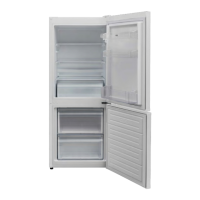31
Refrigerator compartment
Therefrigeratorcompartmentisusedforstoringfreshfoodforafewdays.
• Donotplacefoodindirectcontactwiththerearwalloftherefrigeratorcompartment.Leavesome
spacearoundfoodtoallowcirculationofair.
• Donotplacehotfoodorevaporatingliquidintherefrigerator.
• Alwaysstorefoodinclosedcontainersorwrapped.
• Toreducehumidityandavoidformationoffrost,neverplaceliquidsinunsealedcontainersinthe
refrigerator.
• Meatofalltypes,wrappedinpackages,isrecommendedtobeplacedontheglassshelfjustabovethe
vegetablebin,wheretheairiscolder.
• Youcanputfruitandvegetablesintothecrisperwithoutpackaging.
• Toavoidcoldairescaping,trynottoopenthedoortoooften,andnotleavethedooropenforalong
time.
• For normal working conditions, it will be sufficient to adjust the temperature setting of your
refrigerator to +4 °C.
• The temperature of the fridge compartment should be in the range of 0-8 °C, fresh foods below 0 °C
are iced and rotted, bacterial load increases above 8 °C, and spoils.
• Do not put hot food in the refrigerator immediately, wait for the temperature to pass outside. Hot
foods increase the degree of your refrigerator and cause food poisoning and unnecessary spoiling of
the food.
• Meat, fish, etc. should be store in the chiller compartment of the food, and the vegetable
compartment is preferred for vegetables. (if available)
• To prevent cross contamination, meat products and fruit vegetables are not stored together.
• Foods should be placed in the refrigerator in closed containers or covered to prevent moisture and
odors.
PART 3. FOOD STORAGE IN THE APPLIANCE
FOOD
MAXIMUM STORING
TIME
WHERE TO PLACE IN THE
FRIDGE DEPARTMENT
Vegetables and fruits
1week Vegetablebin
Meat and fish
2-3Days
Wrappedinplasticfoilorbagsorina
meatcontainer(ontheglassshelf)
Fresh cheese
3-4Days Inspecialdoorshelf
Butter and margarine
1week Inspecialdoorshelf
Bottled products milk
and yoghurt
Untiltheexpirydate
recommendedbytheproducer
Inspecialdoorshelf
Eggs
1month Intheeggshelf
Cooked food
—
Allshelves

